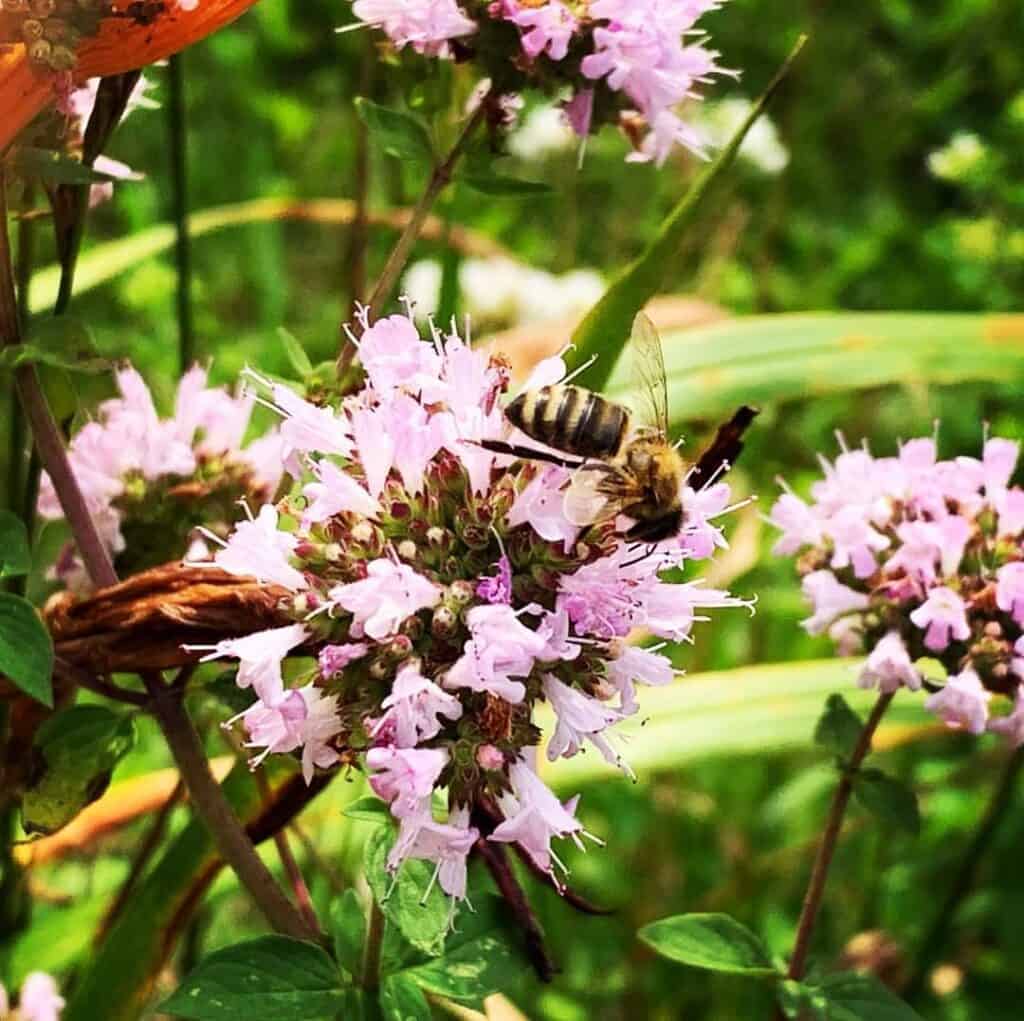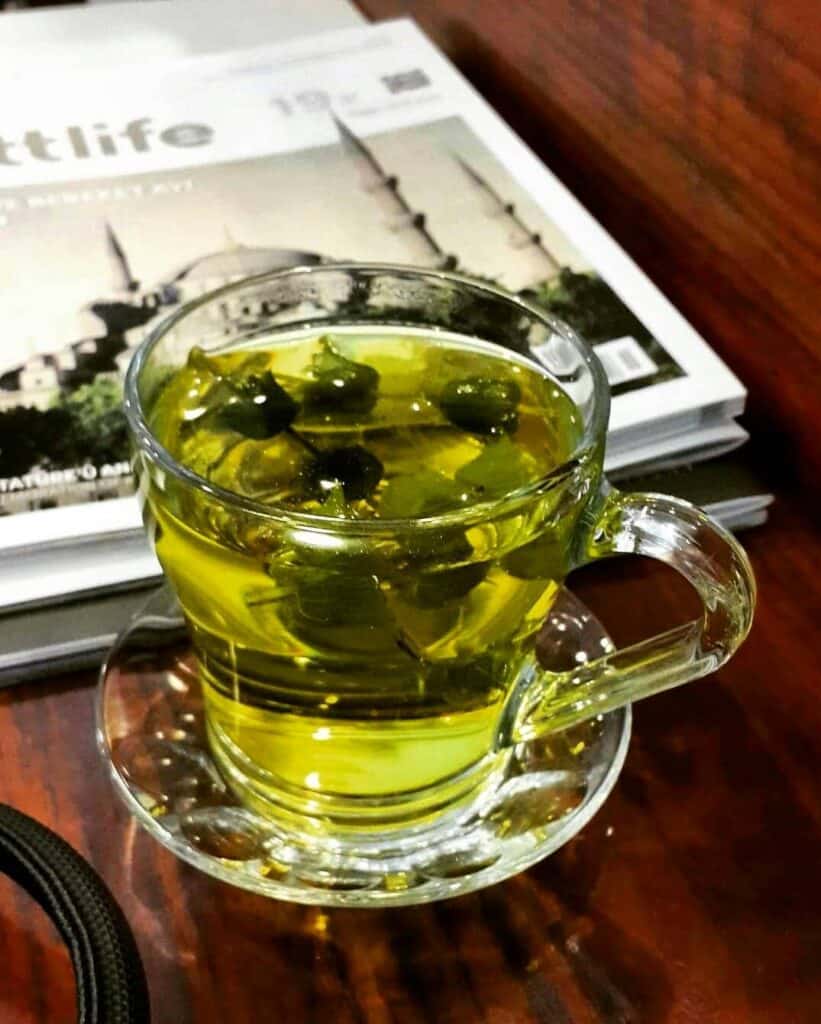If you frequently harvest your Oregano for its delicious leaves, you would know this herb is not supposed to produce flowers.
However, growing Oregano flowers will add colors to the rather dull-looking herb and provide unique benefits.
Therefore, you can allow some of your Oregano bushes to bloom each year instead!

You can obtain healthy seeds from Oregano blossoms, allowing you to grow more herbs.
So, read more about the facts, uses, and Oregano flower benefits.
Table of Contents Show
What do Oregano Flowers Look Like?
Oregano (Origanum vulgare) will blossom around summer with tiny flowerings hardly measuring 3 to 4 mm long.
Unlike its medium-sized foliage, the flowers are tiny, which would look purple, pink-rose, and sometimes white, depending on the species.
Some other varieties, such as Greek Oregano, Italian Oregano, and Syrian Oregano, have white flowers.

Mediterranean Oregano flowers will appear in circular cluster shapes, while Mexican Oregano flower appears as pinnacle or erect spikes.
However, you could spot these flowers quickly because they form clusters and may appear like a bouquet.
These perennial herbs will come back every year without needing to be replanted. In fact, these plants attain maturity 80 to 90 days after sowing seeds.
You can begin harvesting leaves in 6 to 8 weeks and flowers every summer.
The outdoor-grown Oregano is more likely to attain a taller structure and blossom with fuller flower clusters on the end of the stem.
Here are a few details about the Oregano flower.
| Flower Properties | Detail |
|---|---|
| Structure | Tiny, small headed flowers with multiple petals and varied colors |
| Size | 3–4 mm (1⁄8–3⁄16 in) |
| Color | White, rose-pink, and purple |
| Fragrance | Scent similar to Oregano leaves but in milder form |
| Toxicity | Non-toxic to human and pets. |
| Edible part | Entire flower dried and shredded into bits |
| Blooming Season | Buds appear in early spring Full bloom during summer |
Once these plants start producing seeds, the flower will wilt and lose color and structure.
Therefore, do not be surprised when your Oregano flowers start dropping after summer but remember, once these plants fully bloom, there is no turning back.
Oregano Flower Meaning and History
First introduced by the Greeks as a decorative and culinary plant, the name Oregano comes from the Greek words oros and ganos, which stand for “Mountain” and “Joy.”
They believed that the Goddess Aphrodite created the herb as a symbol of joy in the garden.
Since then, the herb has been passed down to Romans, North African and Mediterranean tribes, and the Americas.
It has been used as a condiment for ages since its introduction to Italian cuisine, where it plays a crucial ingredient in tomato sauces.

The herb journeyed into China during that time and was fervently used as a medicinal herb to cure fever, vomiting, and upset stomach.
Once Americans brought it during their Italian campaign in World War 2, the herb was introduced into many different cuisines and medicine.
Therefore, you would find two types of Oregano, Mediterranean, and Mexican, where it the prior is native to temperate western and southwestern Eurasia and the Mediterranean region.
Oregano oil and tea are used globally, and both leaves and flowers are used for this purpose.
Oregano vs. Marjoram Flowers
Many gardeners confuse Majoram with Oregano. There are different herbs with interchangeable names.
Oregano is considered wild Marjoram because of its stronger taste and scent, and Marjoram is known as sweet Marjoram.
Marjoram is a commonly used herb as a sweeter alternative to spicier Oregano because it boasts a milder taste.
Like Oregano, Majoram blossoms every summer with tiny, clustered flowers in shades of purple, pink, or white.
Therefore, no gardener can tell whether Oregano and Marjoram flowers are different.
Like Oregano, you should avoid Marjoram from blooming to keep harvesting its delicious leaves. Otherwise, cut it down to ground level after the blossoms wilt to give it a fresh start.
The Marjoram flowers and leaves are steam-distilled to produce an essential oil with many beneficial components, some of which are borneol, camphor, and pinene.
Note: Oregano has a concentration of the aromatic compound called carvacrol, which gives it its savory flavor. Marjoram is sweeter as it isn’t high in carvacrol.
Uses of Oregano Flowers
Oregano is one of the most popular Mediterranean herbs, which boasts
It has been used to cure many conditions, including skin sores, sore muscles, asthma, cramps, diarrhea, and more.
Greek, Mediterranean, Italian, Syrian, Golden, and Mexican oregano are a few popular Oregano plants in different parts of the world that produce blossoms.
You should know what different purposes they serve once you decide to harvest these blooms.
1. Oregano Tea
Oregano leaves, and flowers are also infused into tea to make an herbal drink.
Both Oregano leaves and flowers contain phenolic glucosides (phenols) that have antioxidant and antimicrobial properties.

However, herbal tea made only from Oregano flowers may taste milder than tea made from leaves and can be slightly costlier.
You can easily make Oregano tea at home by drying the blooms and boiling them to serve as tea. It may help treat cold symptoms, stomach upset, ad headaches.
2. Food Condiments
Oregano has the best culinary implication because the delicious Oregano leaves have been used as a condiment for ages.
However, Oregano flowers have hardly received the same prestige as the leaves because of their less intense flavor and scent.
You can use the Oregano flowers like the leaves by adding them directly to the food or drying them beforehand.
Dried Oregano flowers can be garnished with cheese, salad, cocktail, or dessert.
Moreover, you can add dried and crushed flowers to pasta sauce or use them in different Oregano flower recipes.
3. Home Decoration
Oregano plant flowers are best for different kinds of decorations.
Some home decorators prefer combing fresh blooms from Oregano, Lavender, Mint, or Thyme flowers to make a bouquet with mixed scents.

Cut the fresh flower spikes using a pruner to add them to a flower vase by the window or desk.
Besides using the fresh harvest for decoration, you can tie the stems in a bunch and hang them upside down in a well-ventilated area to dry.
Once dried and crisp, add them to homemade potpourri or flower arrangements that burst with flavor.
4. Beneficial in Pollination
Oregano flowers make excellent pollinators in any garden by attracting bees, ladybugs, butterflies, and small birds.
It may help with cross-pollination and help keep the garden thriving, keeping your Oregano bush ready for another bloom.

Allowing the plants to bloom will add to the decoration and sweet scent and keep the garden ecosystem growing strong.
So, consider growing Oregano-friendly plants in the garden to boost the number of pollinators.
5. Seed Production
The best advantage of allowing Oregano flowers to bloom is getting seeds you can propagate in the soil.
Once the flowers bloom in summer and the pollinators suck its nectar-filled flower, it will make way for seed production.
Wait until the flower heads have started to turn brown and crumble but not too much. It may be the best time to harvest the flower to obtain seeds from the fresh seedpods.
Cut the stems and hang them dry for a week. Next, please put them in a paper bag and gently shake them to exert seeds.
Once you can enough Oregano seeds, consider propagating them at home using a germination kit.
Is Oregano Flower Toxic?
Like any herb, Oregano is safe for consumption in typical food but may become fatal when consumed in high dosages.
As pointed out by Webmd, Oregano is toxic and even lethal in large doses as it has a diuretic effect (releases extra water and salt from the body).
Oregano oil may be harmful when applied in a higher dosage as it contains carvacrol, β-fenchyl alcohol, thymol, and γ-terpinene.
It is better to keep small animals like cats and dogs away from the plant to avoid the risk of poisoning.
ASPCA has kept Greek Oregano flowers (Origanum vulare hirtum) in their list of toxic plants for dogs and cats.
Excess ingestion of the plant’s leaves and flowers may cause mild vomiting and diarrhea.
Furthermore, many people often get confuse Oregano with other lookalike weeds that are toxic to consumption.
Here are a few hotlines you can call if you suspect your pets have consumed Oregano and they start to show signs of poisoning.
- Animal Poison Control Center: 888-426-4435
- Pet Poison Helpline: 855-764-7661
How to Store Oregano Flowers?
There are various methods of storing Oregano flowers. Some of them are as follows.
1. Drying
Drying is the most common method of storing Oregano flowers and leaves.
- Cut the stem with flower clusters in summer and bind a few stems together using a rope.
- Next, hang them by the ceiling in a warm area with indirect sunlight for a week before using them.
- Otherwise, remove the dried Oregano herb flowers from the stem and keep the extracts in a glass jar stored in a dark place.

2. Refrigeration
You can refrigerate fresh Oregano harvests, including leaves and flowers, to store for a few days.
- Keep the fresh harvest in a plastic bag or Ziploc and refrigerate for up to three days.
- Alternatively, place a slightly damp paper towel and leave some air in the bag to store it for up to one week.
3. Dehydrating
Dehydrating the Oregano leaves and flowers may work well for long-duration storage.
- Wash the Oregano harvests and rinse the excess water before placing them in the dehydrator tray.
- Please set it to the lowest setting, 95 to 125°F, and leave it for 6 to 18 hours.
Note: Dehydrating Oregano flowers may work best when drying a large batch for storing purposes.
You can also make Oregano-infused olive oil. Simply put oil in a cooker, add Oregano flowers, and cook for one hour.
Leave the oil to cool down and pour the infused oil into a jar. You can use it for one month.
From Editorial Team
Oregano flowers possess similar benefits provided by Oregano leaves; therefore, it may be worthwhile to let them bloom.
However, remember to harvest the flowers before they begin to die in late summer and store them appropriately.
Follow this guide to prepare and use Oregano flowers for different household purposes.


